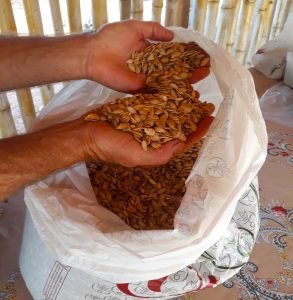Seeds for the Argonauts of the Pantanal
Guató peoples Copyright Jorge Eremites de Oliveira 2016
Corn Seeds Image by Stephen Smith from Pixabay
In Brazil’s Pantanal, the world’s largest tropical wetland with a high concentration of rare or endangered species, weeks of raging fires driven by climate change and policy contempt have decimated wildlife populations and territories where Indigenous communities live.
Small fires occur every year in the region, but this year, the number of fires in the Pantanal more than doubled in the first half of 2020 compared to the same period last year, according to government data. NASA Earth Observatory holds the view that the extraordinarily dry conditions of 2020 have meant that many fires that were lit intentionally- often to maintain pastures by cattle ranchers- have been escaping and burning uncontrolled throughout the Pantanal ecosystem.
Pumpkin Seeds Image by Menegildo Tozetti Braga
A report issued by the Laboratory for Environmental Satellite Applications, Federal University of Rio de Janeiro this week states that despite the race against the fire, three indigenous territories have been consumed by the flames. The Teresa Cristina territory had 25.7 thousand hectares burnt while the Baia of Guatós lost the equivalent of 83.2% of their land, and the fires consumed 99% of the Perigara area.
The flames destroyed homes and plantations, leaving the Guató people without food and drinking water. Under the guidance and request of the Guató leader Alessandra Guató, Artists Project Earth – APE-UK- is supporting their people by sourcing native and regional seeds to start new crops. Native varieties of beans, pumpkin, porungo, corn, yuri, caxi, favas, cravo, caxi, bucha, melga have been collected and transported through APE’s support. The campaign for Seeds to the Guató continues.
Vulnerable for losing the resourcefulness of their ancestral territory one of the leaders Alessandra Guató stated: ‘we are one with the land, we live from the land and now is all devastated’. This is confirmed by the anthropologist Jorge Eremites who explains how the Guató follow the natural cycles of filling and emptying of the Pantanal floodplain by adapting their settlements seasonally. The macaraípó at the edge of the riparian forests and high fields, the modidjécum at the riverside, the marraboró at swampy areas. In these different settlements, the Guató would be following the natural cycles of transformation of the Pantanal landscape, which have now been disrupted.
The Pantanal is home to a rich archaeological past with recognised sites of cultural traditions. The indigenous way of life and many of the traditions of these first inhabitants still withstand in the culture of the riverside people of the Pantanal, especially the elements related to the Guató peoples. Great canoe travellers, growers and fishermen, known as the Argonauts of the Pantanal their story and predicament move us at Artists Project Earth.


